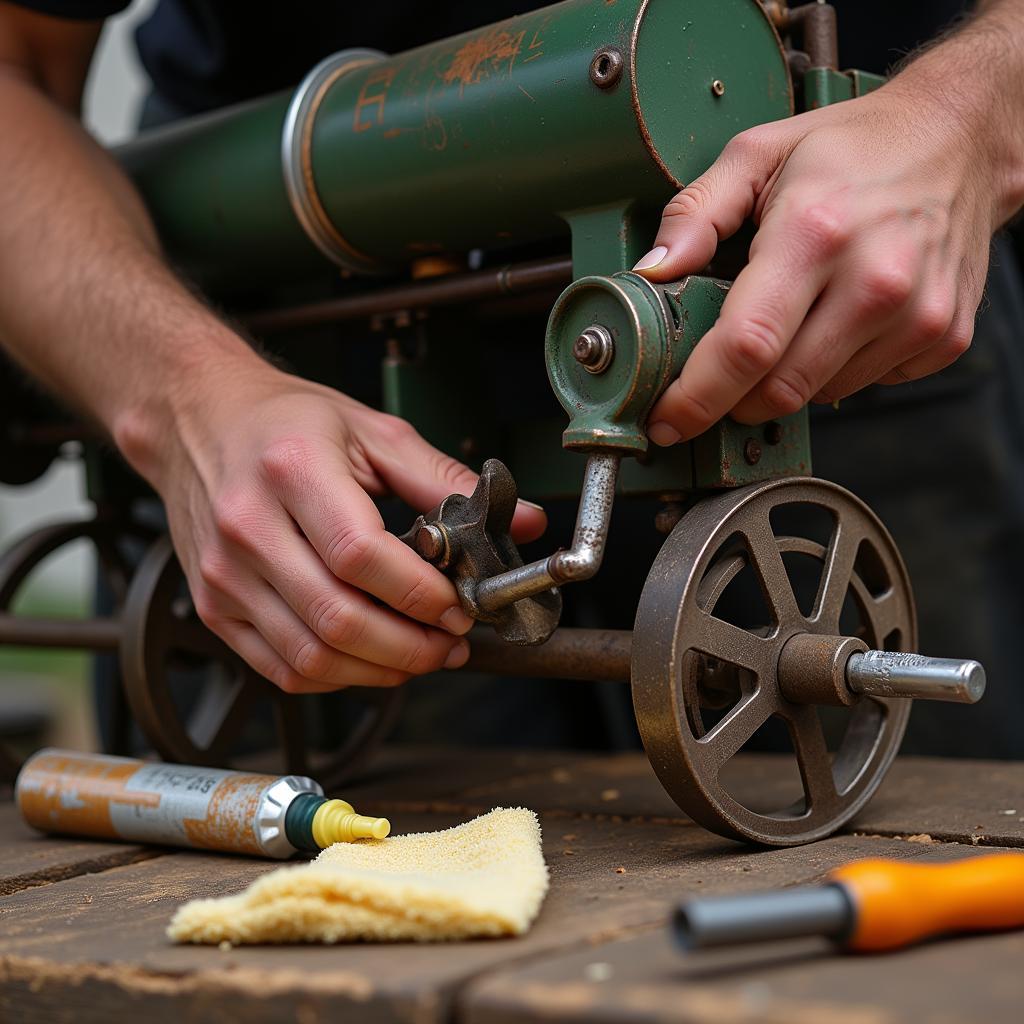A grain drill is a crucial piece of equipment for anyone serious about establishing successful food plots. Selecting the right Grain Drill For Food Plots can significantly impact the overall success of your planting efforts, impacting everything from seed germination to forage yield. Choosing the wrong one can lead to wasted seed, poor germination, and ultimately, a disappointing food plot. Let’s delve into the world of grain drills and discover how to choose the perfect one for your needs.
Planting a successful food plot requires precision and the right equipment. A rye food plot is a popular choice among hunters and wildlife enthusiasts.
Understanding the Importance of a Grain Drill
Why use a grain drill at all? While broadcasting seed might seem easier, a grain drill offers several advantages that make it the preferred method for establishing food plots. Grain drills accurately place seeds at the correct depth, ensuring optimal germination rates. They also control the seed spacing, preventing overcrowding and competition. This precise planting leads to healthier, more vigorous plants and ultimately, a more productive food plot. Furthermore, grain drills create furrows and cover the seed, protecting it from birds and weather.
Benefits of Using a Grain Drill
- Improved Germination Rates: Consistent planting depth leads to better germination.
- Uniform Plant Growth: Controlled seed spacing promotes healthy and even growth.
- Reduced Seed Waste: Precise planting minimizes the amount of seed required.
- Protection from the Elements: Furrows and seed covering protect seeds from birds and harsh weather.
Types of Grain Drills for Food Plots
Several types of grain drills are available, each with its own strengths and weaknesses. Understanding these differences is crucial for selecting the right drill for your food plot needs.
No-Till Drills
No-till drills are designed to plant seeds directly into existing vegetation without prior tillage. They are an excellent option for minimizing soil disturbance and promoting healthy soil structure. They’re ideal for areas with erosion concerns or where minimal ground preparation is desired.
Conventional Drills
Conventional drills require a prepared seedbed, meaning the ground needs to be tilled before planting. These drills are often less expensive than no-till drills and can be a good option for smaller food plots.
Overseeders
Overseeders are designed to plant seeds into existing stands of vegetation, making them ideal for renovating existing food plots or adding diversity to established pastures.
Factors to Consider When Choosing a Grain Drill
Choosing the right grain drill involves several key considerations.
Size and Scale of Food Plot
The size of your food plot will heavily influence the type and size of drill you need. Smaller plots may be manageable with a hand-pushed drill or a smaller ATV-pulled model. Larger plots require larger, tractor-pulled drills for efficient planting.
Terrain and Accessibility
Consider the terrain of your food plot. If it’s hilly or uneven, a no-till drill might be a better choice than a conventional drill. Also, consider the accessibility of your plot. Can a tractor and drill easily reach the area?
Budget
Grain drills range in price from a few hundred dollars for hand-pushed models to several thousand for larger, tractor-pulled units. Setting a budget beforehand will help narrow down your options.
For smaller food plots, a deer food plot in woods may only require a handheld spreader or a small ATV-pulled drill.
Seed Type and Planting Requirements
Different seeds have different planting depth and spacing requirements. Ensure the drill you choose can accommodate the specific seeds you plan to use, whether it’s a rye grain food plot or a triticale food plot.
Maintaining Your Grain Drill
Proper maintenance is essential for prolonging the life of your grain drill. Regular cleaning, lubrication, and storage in a dry location will help prevent rust and ensure your drill is ready for the next planting season.
Conclusion
Selecting the right grain drill for food plots is a vital investment for any serious food plot enthusiast. By carefully considering factors such as plot size, terrain, budget, and seed type, you can choose a grain drill that will help you establish thriving, productive food plots for years to come. Remember to maintain your grain drill properly to ensure its longevity and continued performance. Knowing when to plant turkey food plots is also important for successful food plot establishment.
 Grain Drill Maintenance
Grain Drill Maintenance
When do you plan to plant your next food plot?
FAQ:
- What is the best type of grain drill for small food plots?
- How deep should I plant seeds with a grain drill?
- Can I use a grain drill for planting both small seeds and larger seeds like corn?
- How do I calibrate a grain drill to ensure accurate seeding rates?
- What maintenance is required for a grain drill?
- Where can I buy a grain drill for food plots?
- How do I choose the right size grain drill for my property?
Need more help with your food plots? Check out our articles on rye grain food plots, triticale food plots, and deer food plots in the woods.
For any further assistance, please contact us at Phone Number: 02437655121, Email: [email protected] Or visit us at: 3PGH+8R9, ĐT70A, thôn Trung, Bắc Từ Liêm, Hà Nội, Việt Nam. We have a 24/7 customer service team.